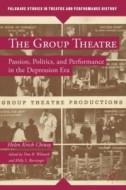Book Review: The Group Theatre
The Group Theatre: Passion, Politics, Performance in the Depression Era
Chinoy, Helen Krich
Edited by Don B. Wilmeth and Milly S. Barranger
New York: Palgrave MacMillan, 2013
ISBN: 9781137294593
283 pp.
The Group Theatre is the posthumous publication and culmination of author Helen Krich Chinoy’s lifelong dedication to the history of this landmark American theatre company. Thanks to the diligent efforts of editors Don B. Wilmeth and Milly S. Barranger, following Chinoy’s death in 2010, readers will benefit from her in-depth knowledge of The Group. While not without its faults, the book is one the most engaging and objective accounts of The Group Theatre’s history published to date.
The work is separated into two major sections; the first encompassing a thorough and compelling history of the company, beginning with initial talks held by co-founders Harold Clurman, Lee Strasberg and Cheryl Crawford, and concluding with the company’s final production of Clifford Odets’ Night Music. Framing the majority of this first section within the scope of the company’s performances provides enough focus to give the writing direction without getting lost down too many tangential paths. That is not to say the work suffers from a lack of detail. On the contrary, Chinoy excels at juggling the various personalities that inhabited the Group during its ten-year existence. In addition to the most well known figures (Clurman, Strasberg, Stella Adler, etc.), Chinoy expertly breathes life into the “lesser” known members of the company (Eunice Stoddard, Ruth Nelson, etc.). Where other works, most notably Clurman’s The Fervent Years: The Group Theatre and the Thirties, either assume knowledge of specific Group productions and players or gloss over them completely, Chinoy’s account of the Group benefits from both succinct summaries of each production and the inclusion of perspectives from a wide swath of Group members. One of the most successful elements of this approach is the actors’ descriptions of Clurman’s and Strasberg’s artistic processes. These first-hand accounts do a wonderful job of peeling back the curtain on two of American theatre’s most influential directors.
The second part of the book, titled “Politics,” situates the Group in broader social and political contexts. Reading more like a collection of essays, this section lacks the narrative fluidity of the first part but performs the critical task of investigating often-overlooked aspects of the theatre’s history, including the strong communist elements within the Group and the liminal space held by women in the male dominated company (both topics neglected in The Fervent Years).
Despite the many strong points, there are serious problems with the work. As the editors note in the preface, Chinoy did not properly cite all sources used, and though the editors attempted to trace references, some remain absent. As a result, one must put faith in the author’s years of close contact with Group members and her dedication to researching the subject when reading this work. Additionally the book would be better served by incorporating some of the latter chapters into the narrative history of the first portion of the book, especially the chapter on the Group’s dissolution. Despite these drawbacks, Chinoy’s The Group Theatre is a landmark publication and an essential purchase for any library with collections in American theatre history.
Michael Saar
Lamar University

